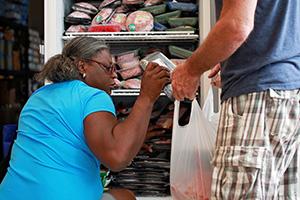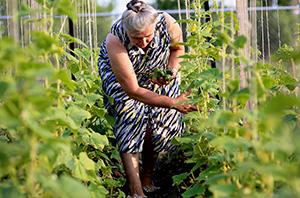What’s in a grocery bag may surprise you
By Craig Dirkes, writer/photographer at The Salvation Army Northern Division
The Salvation Army’s 22 food shelves in Minnesota and North Dakota give out about 186,000 bags of groceries a year.
You might wonder: What kinds of foods are in each bag? And how much?
We’ll get to those questions in a moment. But first, let us explain the most important thing that goes into each bag.
“We think deeply about the foods we want to offer before we offer them,” said Krystle Englund, a licensed Salvation Army social worker who helps oversee our food shelves. “Are the foods healthy? Easy to prepare? What kinds of meals can be made with them?”
To help our guests answer that last question, some of our food shelves insert recipe cards into their food bags. A popular recipe is stir fry, which can be cooked with ingredients offered at almost all of our food shelves: rice, veggies, meat, seasoning, and cooking oil.
Something else we think about: perishable vs. nonperishable.
 “We try to offer as many perishables as we can – they’re healthier,” Englund said. “Also, perishables tend to be the most expensive foods for our guests to buy in a grocery store. So that helps them a lot.”
“We try to offer as many perishables as we can – they’re healthier,” Englund said. “Also, perishables tend to be the most expensive foods for our guests to buy in a grocery store. So that helps them a lot.”
Perishables typically include meat, milk, eggs, and produce.
“I especially like the meat and the produce,” said a food shelf guest named Rebecca, 33, a working single mother living in the southern Twin Cities metro area. She stops by her local Salvation Army food shelf every so often, when unexpected bills arise.
Additional thought goes into the distribution style of our food shelves. For instance, many of our locations are “grocery-style,” allowing guests to pick which foods they want and leave the ones they don’t. This eliminates waste by ensuring guests eat all the food they receive.
What’s in a bag?
Now, back to the original question: After people come to a Salvation Army food shelf, what do they leave with?
 For starters, food to create balanced meals. Guests receive specific amounts of foods from these and other categories:
For starters, food to create balanced meals. Guests receive specific amounts of foods from these and other categories:
- Starch (pasta, rice, potatoes)
- Dairy (milk, cheese, butter)
- Meat (beef, chicken, fish)
- Bread
- Veggies
- Fruit
Guests can also pick from an assortment of condiments such as ketchup or salad dressing, along with baking items such as sugar and flour.
“We focus on providing basic staples that can become meals on dinner tables,” Englund said.
As for food amounts, guests typically receive anywhere from 10 to 15 pounds of groceries for every person in their family.
“The poundage may differ, but we always try to provide each person with enough food for nine nutritious meals,” said Englund, adding that guests can receive these foods once per month.
 In addition to food shelf items, most Salvation Army locations offer free bread every weekday, as supplies allow. Guests are free to take whatever they need, as often as they want, without an appointment.
In addition to food shelf items, most Salvation Army locations offer free bread every weekday, as supplies allow. Guests are free to take whatever they need, as often as they want, without an appointment.
A senior named Kathy spent years coming to The Salvation Army for bread during a time when she and her husband lived on less than $200 per month.
“I showed up for bread almost every day,” said Kathy, who now volunteers at her local Salvation Army to “give back a little.”
What to donate
The Salvation Army encourages you to support our food shelves by donating money or dropping off food.
Food donors: In addition to dropping off nonperishables such as canned goods and boxed foods, also consider giving one or more of the following items, which typically are in high demand but short supply:
- Peanut butter
- Hygiene supplies (toothpaste, soap, shampoo, toilet paper)
- Baby items (diapers, food, formula)
- Ethnic foods (bamboo shoots, baby corn, rice, coconut milk, tortillas, maize)
- Special diet (low-sugar, low-sodium, gluten-free)
 Another option: Donate fresh fruits, veggies, and other perishables; or, if you’re a gardener, grow a row for The Salvation Army and give a portion of your abundance.
Another option: Donate fresh fruits, veggies, and other perishables; or, if you’re a gardener, grow a row for The Salvation Army and give a portion of your abundance.
“We happily accept donations of perishable foods if they are given, in person, to a Salvation Army staff member at one of our food shelves,” Englund said. “As long as the perishable foods are in their original packaging and/or haven’t expired, we’ll take them.”
Please join The Salvation Army by volunteering or making a donation to support food programs in your local community today.

